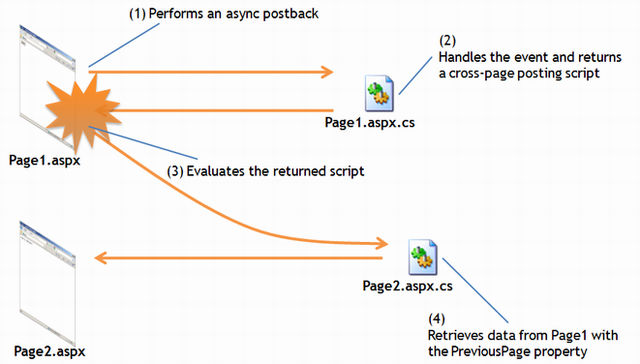Performing Cross-page Posting in an Event Handler
5.00/5 (1 vote)
This article describes an idea of the ASP.NET page transfer method that can be called like the Response.Redirect method and works as cross-page posting.
Table of Contents
- Introduction
- Concept
- Use an async postback to request server
- Return a cross-page posting script as the response of the async postback
- Evaluate the returned script
- Retrieve previous page data with the PreviousPage property
- Example of Implementation
- History
Introduction
This article describes an idea of the ASP.NET page transfer method that can be called like the Response.Redirect method and works as cross-page posting.
When I develop ASP.NET applications, I often use cross-page posting to transfer and to pass page data to another page. The advantage of cross-page posting is that the transferred page can access the previous page to retrieve page data. It reduces the cost of session management. So, I prefer to use cross-page posting.
But, there is one thing I don't like about cross-page posting; it can't perform in an event handler. When we set value to the Button.PostBackUrl property to perform cross-page posting, unfortunately, the click event handler doesn't work. For this reason, if we want to transfer to another page after doing something in an event handler, we can't use cross-page posting.
Thus, when we use cross-page posting, we have to use several implementation techniques. In some cases, we have to set the PostBackUrl property to perform cross-page posting. And in other cases, we have to implement an event handler to transfer to another page with the Response.Redirect method after doing something (although the HttpServerUtility.Transfer method can also be used, I don't want to use it). In addition, then, we must use session or query string to pass data to another page.
Consequently, the implementation of page transfer and data passing becomes complex.
To mitigate this complexity, I have come up with a mechanism that performs cross-page posting in an event handler. It always allows us to transfer and to pass data to another page with cross-page posting.
Concept
The concept of my idea is illustrated in Fig 1.

The following are the main points of my idea:
- Use an async postback to request server
- Return a cross-page posting script as the response of the async postback
- Evaluate the returned script
- Retrieve previous page data with the
PreviousPageproperty
1. Use an Async Postback to Request Server
The ScriptManager.endRequest event will be raised when an async postback is completed. So, this event allows you to perform additional processes in client-side after completion of an async postback.
2. Return a Cross-page Posting Script as the Response of the Async Postback
The ClientScriptManager.GetPostBackEventReference method allows you to create a cross-page posting script in a server-side event handler. This method returns a cross-page posting script as string when you pass an instance of the PostBackOption class that is set up appropriately.
The ScriptManger.RegisterDataItem method can be used to return the created script as the response. This method allows you to store any data in the dataItems array. And, the dataItems array can be accessed in the endRequest event handler.
3. Evaluate the Returned Script
In the endRequest event handler, you can retrieve the returned cross-page posting script via the dataItems array. When you pass its script to the eval method, the cross-page posting is performed.
4. Retrieve Previous Page Data with the PreviousPage Property
As with normal cross-page posting, previous page data can be accessed with the PreviousPage property from a next page. Naturally, the PreviousPageType directive also works.
Example of Implementation
<body>
<form id="form1" runat="server">
<asp:ScriptManager ID="scriptManager" runat="server" />
<asp:UpdatePanel ID="updatePanel" runat="server">
<ContentTemplate>
<asp:Button ID="submitButton" runat="server"
Text="Submit" OnClick="Submit" />
</ContentTemplate>
</asp:UpdatePanel>
</form>
</body>
using System;
using System.Text;
using System.Web;
using System.Web.UI;
namespace SampleCode
{
public partial class Page1 : Page
{
public string OrderNo
{
get
{
return (string)ViewState["OrderNo"];
}
private set
{
ViewState["OrderNo"] = value;
}
}
protected override void OnLoad(EventArgs e)
{
base.OnLoad(e);
StringBuilder script = new StringBuilder();
script.Append("var manager =
Sys.WebForms.PageRequestManager.getInstance();");
script.Append("manager.add_endRequest(function(sender, args) {");
script.Append(" if (args.get_error() == undefined) {");
script.Append(" var dataItems = args.get_dataItems();");
script.Append(" var item = dataItems['" + ClientID + "'];");
script.Append(" if (item != undefined) {");
script.Append(" eval(item);");
script.Append(" }");
script.Append(" }");
script.Append("});");
ClientScript.RegisterStartupScript(GetType(),
"doCrossPagePostBack", script.ToString(), true);
}
protected void Submit(object sender, EventArgs e)
{
Random r = new Random();
OrderNo = String.Format("OD{0:00000000}", r.Next(0, 99999999));
NavigateTo("~/Page2.aspx");
}
private void NavigateTo(string url)
{
ScriptManager manager = ScriptManager.GetCurrent(this);
if (manager.IsInAsyncPostBack)
{
if (VirtualPathUtility.IsAbsolute(url) == false)
{
url = VirtualPathUtility.ToAbsolute(url);
}
PostBackOptions o = new PostBackOptions(this, String.Empty, url,
false, false, false, true, false, String.Empty);
manager.RegisterDataItem(this,
ClientScript.GetPostBackEventReference(o));
}
}
}
}
<body>
<form id="form1" runat="server">
<asp:Label ID="orderNoLabel" runat="server" Text="Order No :" />
<asp:Label ID="orderNoValueLabel" runat="server" />
</form>
</body>
using System;
using System.Web.UI;
namespace SampleCode
{
public partial class Page2 : Page
{
protected override void OnLoad(EventArgs e)
{
base.OnLoad(e);
if (PreviousPage != null && PreviousPage.IsCrossPagePostBack)
{
Page1 previousPage = (Page1)PreviousPage;
this.orderNoValueLabel.Text = previousPage.OrderNo;
}
}
}
}
History
- 2009-05-06: Published
